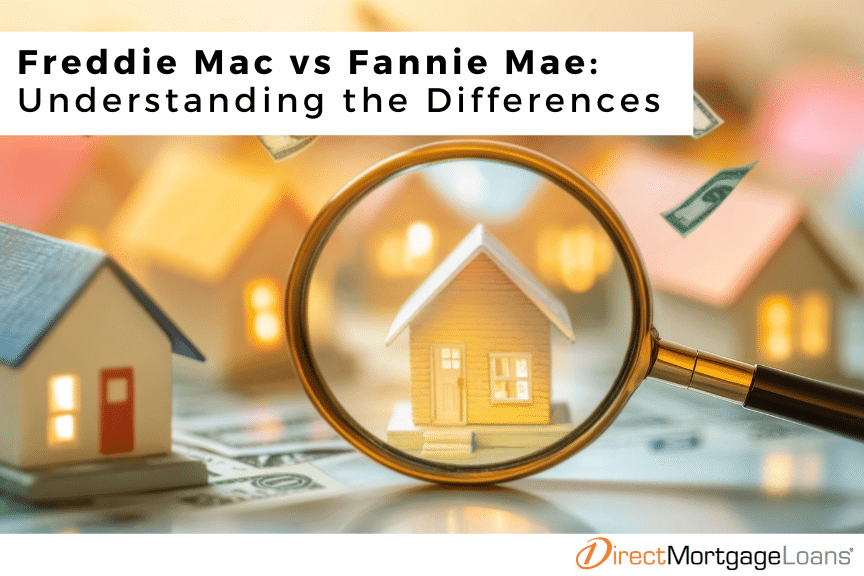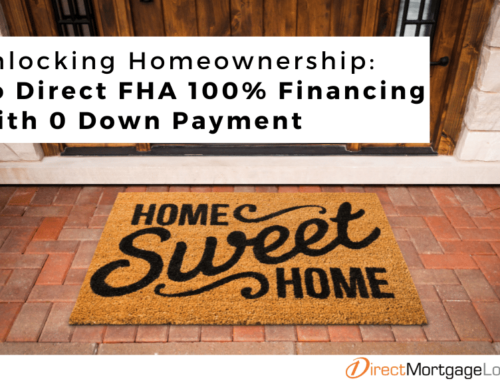Fannie Mae and Freddie Mac play vital roles in the U.S. housing market, but their similarities often lead to confusion. This guide will help you understand the differences between these two organizations and how they impact your mortgage options.
Subscribe to our blog to receive notifications of posts that interest you!
What is Freddie Mac?
Freddie Mac, formally known as the Federal Home Loan Mortgage Corporation (FHLMC), was established in 1970 to expand the secondary mortgage market. Freddie Mac purchases mortgages from lenders, bundles them into securities, and sells them to investors. By doing so, it helps maintain liquidity in the housing market, ensuring lenders have funds to offer new loans.
What is Fannie Mae?
Fannie Mae, or the Federal National Mortgage Association (FNMA), was created in 1938 during the Great Depression to encourage homeownership. Like Freddie Mac, Fannie Mae buys mortgages from lenders and converts them into mortgage-backed securities. This process stabilizes the housing market and helps make homeownership more accessible.
What do Fannie Mae and Freddie Mac do?
Both organizations serve as government-sponsored enterprises (GSEs) with a shared mission: to promote stability and affordability in the housing market. By purchasing mortgages from lenders, they provide liquidity, enabling lenders to offer a wider variety of loan products. Their operations also set the standards for conventional loans, influencing eligibility criteria like credit score and income requirements. Talking to an experienced loan officer at Direct Mortgage Loans could help you understand more about your options.
Who is the regulator for Freddie Mac and Fannie Mae?
The Federal Housing Finance Agency (FHFA) oversees both Freddie Mac and Fannie Mae. Established in 2008, the FHFA ensures these entities operate efficiently, adhere to federal guidelines, and support their mission of promoting access to affordable housing.
What is the difference between Freddie Mac and Fannie Mae?
While both entities have similar roles, there are notable differences that set them apart:
- Loan Origination: Freddie Mac primarily collaborates with smaller banks and credit unions, focusing on making home loans accessible through community-level financial institutions. In contrast, Fannie Mae partners with larger financial institutions, offering a broader reach for its loan products.
- Loan Programs: Each entity has tailored programs to meet the needs of various borrowers. Freddie Mac’s Home Possible® program is specifically designed to assist first-time buyers and those with low-to-moderate incomes by offering flexible options, such as low down payments. Similarly, Fannie Mae’s HomeReady® program targets similar demographics, providing affordability features like reduced mortgage insurance requirements and eligibility for non-traditional income sources. Direct Mortgage Loans can confidently lead you to find the best loan for you. Contact a loan officer to get the conversation about Fannie Mae HomeReady loans.
- Eligibility Requirements: The specific qualifications for loans differ slightly between the two. For example, Freddie Mac may focus more on income limits and debt-to-income ratios suited to smaller financial institutions, while Fannie Mae’s criteria often include broader thresholds for borrowers working with larger lenders. These distinctions could influence the types of borrowers each entity serves.
What do Fannie Mae and Freddie Mac have in common?
Both organizations aim to stabilize the housing market by ensuring a steady flow of funds, and they share several common goals:
- Supporting Affordable Housing Initiatives: Both Fannie Mae and Freddie Mac are committed to making homeownership accessible for a wide range of borrowers. They achieve this by implementing programs that promote affordable housing and assist first-time buyers or those with moderate incomes.
- Setting Guidelines for Conventional Loans: These entities establish uniform standards for conventional loans, such as eligibility criteria and documentation requirements. This standardization simplifies the loan process for both lenders and borrowers.
- Reducing Risk for Lenders Through Purchasing and Securitizing Processes: By purchasing loans from lenders and converting them into mortgage-backed securities, Fannie Mae and Freddie Mac help lenders mitigate financial risk. This process also ensures a continuous flow of capital, enabling lenders to provide more loan options to borrowers.
Benefits of Freddie Mac and Fannie Mae Mortgages
Mortgages backed by Freddie Mac and Fannie Mae provide significant advantages for borrowers, making them a popular choice in the housing market. These benefits include:
- Competitive Rates: Borrowers often benefit from lower interest rates on their mortgages because Freddie Mac and Fannie Mae help stabilize the housing finance system. This lower cost of borrowing makes homeownership more attainable for many individuals and families.
- Flexibility: These entities offer diverse loan programs designed to meet various financial needs. For instance, programs such as HomeReady® and Home Possible® provide options for buyers with limited savings for down payments, ensuring greater access to affordable home loans.
- Standardization: Freddie Mac and Fannie Mae establish clear guidelines for conventional loans, which ensures a consistent borrowing experience across lenders. This standardization simplifies the process for both lenders and borrowers, making it easier to navigate the mortgage landscape.
Eligibility Requirements for Freddie Mac vs Fannie Mae Loans
Understanding the eligibility requirements for Freddie Mac and Fannie Mae loans is essential when determining which program best fits your needs. Here is an overview:
Freddie Mac
Freddie Mac’s programs, like Home Possible®, are designed to assist borrowers with modest incomes in achieving homeownership. The typical eligibility criteria include:
- A minimum credit score of 620, ensuring borrowers have a solid credit history.
- Income limits that vary based on the property’s location, targeting assistance to those within certain income brackets.
- A debt-to-income ratio of 43% or lower, which helps ensure borrowers can comfortably manage their mortgage payments alongside other financial obligations.
Fannie Mae
Fannie Mae’s HomeReady® program shares similar objectives, focusing on affordability and flexibility for borrowers. Key eligibility criteria include:
- Credit scores starting at 620, making the program accessible to a wide range of borrowers.
- Income limits at or below 80% of the area median income, allowing low-to-moderate income households to qualify.
- Opportunities to use non-traditional income sources, such as rental or boarder income, to meet the required thresholds, offering additional flexibility for borrowers with diverse financial situations.
How to Choose Between Freddie Mac and Fannie Mae Mortgage Loans
Deciding between Freddie Mac and Fannie Mae loans depends on your financial goals and the options offered by your lender. Both entities provide valuable programs tailored to support different needs. For first-time homebuyers or individuals with limited income, programs like HomeReady® and Home Possible® offer excellent benefits. Additionally, if you’re considering a home purchase that requires renovation, each entity provides specialized loan options to help finance necessary updates. Consulting with a knowledgeable loan officer at Direct Mortgage Loans could help you weigh your options and choose the loan that aligns best with your circumstances.
Freddie Mac Vs Fannie Mae FAQ’s
Can borrowers choose between Freddie Mac and Fannie Mae?
Borrowers typically do not directly choose whether their loan is backed by Freddie Mac or Fannie Mae. Instead, lenders decide which entity to work with based on the characteristics of the loan and their existing partnerships. Understanding your lender’s affiliations could provide insights into which entity might purchase your loan.
What credit score do you need for Fannie Mae or Freddie Mac?
Both entities generally require a minimum credit score of 620 to qualify for their loan programs. However, higher credit scores can unlock more favorable terms, such as reduced interest rates and lower monthly payments.
Are Freddie Mac and Fannie Mae mortgages the same as FHA loans?
No, Freddie Mac and Fannie Mae back conventional loans, which differ from FHA loans insured by the Federal Housing Administration. While FHA loans cater to borrowers with lower credit scores or smaller down payments, conventional loans backed by Freddie Mac or Fannie Mae often offer more competitive terms for borrowers who meet their criteria.
What happens if a loan does not meet Freddie Mac or Fannie Mae standards?
Loans that fail to meet the criteria set by Freddie Mac or Fannie Mae are considered non-conforming. These loans may still be available through other channels but often come with higher interest rates or stricter terms due to the increased risk for lenders.
Are Freddie Mac and Fannie Mae mortgages more affordable?
Yes, mortgages backed by Freddie Mac and Fannie Mae are often more affordable because of their role in reducing risks for lenders. This support translates into competitive interest rates and accessible loan terms for borrowers.
Rates are subject to change. Eligibility and approval are subject to completion of an application and verification of home ownership, occupancy, title, income, employment, credit, home value, collateral, and underwriting requirements. Direct Mortgage Loans, LLC NMLS ID# is 832799 (www.nmlsconsumeraccess.org). Direct Mortgage Loans, LLC office is located at 11011 McCormick Rd Suite 400 Hunt Valley, MD 21031. This is a paid endorsement. Equal housing lender.
How can I tell if my mortgage is with Freddie Mac or Fannie Mae?
Both Freddie Mac and Fannie Mae provide online lookup tools that allow borrowers to check whether their mortgage is owned by either entity. These tools can be found on their respective official websites and are easy to use with basic loan information.






Leave A Comment
You must be logged in to post a comment.